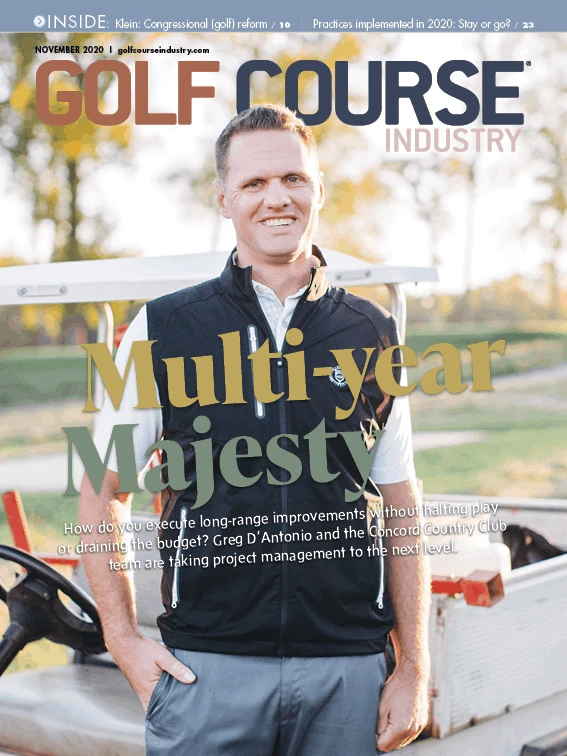
Goodness, has Congressional Country Club come a long way. The legendary 36-hole facility in Bethesda, Maryland, in a Beltway suburb 12 miles northwest of the U.S. Capitol Building, is undergoing a season-long makeover. It won’t reopen until the spring of 2021, but based upon what I saw during a recent preview visit of the work in process it will emerge from its chrysalis totally transformed. It’s not quite a restoration, nor a renovation. Let’s just call it a complete transformation in place.
Credit the club, its board, general manager Jeffrey Kreafle, director of golf Jason Epstein, and course superintendent Peter Wendt and his entire crew. Also kudos to Maryland-based golf course architect Andrew Green, whose meticulous commitment to historical documentation and on-site inspection ensured the details of an ambitious overhaul by golf course builder McDonald & Sons.
On a personal note, it has been fascinating to watch the transformation. I’ve been visiting Congressional since 1980, when I caddied in two Kemper Opens while looping summers on the PGA Tour. As a journalist, I had covered U.S. Opens there in 1997 and 2011. I should also add for purposes of full disclosure that at the invitation of the club in 2016, I returned for a day-long paid consulting visit during which I shared with them my sense of the course and its potential for improvement. But I’ve had no subsequent involvement with the club and had not the slightest inkling of how far they would take things until a visit in mid-October.
Congressional is a big place: 380 acres, with two 18-hole golf courses, the Gold Course and the championship venue Blue Course (home to the U.S. Open in 1964, 1997 and 2011, the PGA Championship in 1976 and 2031, and the Ryder Cup in 2036). The club was founded in 1924 as the focal point for recreation among the nation’s leaders in industry and politics on a non-partisan basis. It remains that way, a rarity in D.C. culture.
The Blue Course was something of a hybrid curiosity. An original 18-hole routing by Devereaux Emmet was split in half by Robert Trent Jones Sr., with the front nine rerouted and revised completely and a new back nine added. The original back nine was used to become the Gold Course in 1977.
The course underwent subsequent renovations in the run-up to its two most recent U.S. Opens, with Rees Jones adding his trademark mounding, variously tinkering with a new par 3 that was the 18th hole in 1997 and the 10th hole in 2011. In the process, Congressional-Blue became heavily tree-lined, with fairway bunkering left and right and play strictly aerial and down the middle. Notorious for its summer heat and humidity, Metro Washington made the place feel like a vegetable steamer, with no relief in the form of air movement. The turf showed the strain. The course provided little emotional engagement.
Enter Andrew Green, who by 2017 had made his mark with a major transformation of Inverness Club in Toledo, Ohio, and was slated next for restorations of Oak Hill-East Course in Rochester, New York, and Scioto Country Club in Columbus, Ohio. Work at Congressional began in October 2019 with extensive tree work and reconstruction of every green, bunker and tee. Along the way, Green solved a perennial routing problem by finding a new site for the 10th hole. The main achievement of the feature work was to make the elements fit in at grade level, provide ground game access to at least part of the greens, and bring the native areas and creek beds more into prominence while enhancing interior views across the site.
Fairways went from 25 acres to 46 — all of it sodded with a 50/50 mix of 007 and Matchplay bentgrasses. The greens, newly planted in 007 (50 percent), Piranha (25 percent) and Coho (25 percent) got 16 percent larger, from 6,100 square feet on average to 7,200, with far more varied hole locations. Every bunker has been outfitted with Better Billy Bunker drainage and snuggled closer to the playing surface, with the leading edge into it mowed down to accentuate its impact on play. And the tree work has opened up the course to wind. It’s as if somebody turned on a big fan.
The engineering work was not simple. In order to maximize erosion control, a series of acre-plus temporary holding ponds had to be built to collect any silt. They will be removed eventually, the areas established with native fescues to create a contrasting palette of plant material. The result overall will be a golf course that looks, feels and plays entirely differently than the old Blue Course.
Who said there were no prospects for Congressional reform? Amazing what happens when decision makers take a serious look and decide it’s time for a major change.
Get curated news on YOUR industry.
Enter your email to receive our newsletters.
Explore the November 2020 Issue
Check out more from this issue and find your next story to read.
Latest from Golf Course Industry
- Toro continues support of National Mayor’s Challenge for Water Conservation
- A different kind of long distance
- Golf Construction Conversations: Stephen Hope
- EnP welcomes new sales manager
- DLF opening centers in Oregon, Ontario
- Buffalo Turbine unveils battery-powered debris blower
- Beyond the Page 66: Keep looking up
- SePRO hires new technical specialist







